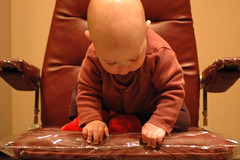ironically, we were encouraged by the clinic staff to not book this eye exam considering how positive the results were from our unexpected exam less than two months ago, unless – of course – we suspected that something was wrong. and we almost did skip it, since neither of us has spent much time thinking about odin’s eyes since our opthamalogic emergency that wasn’t.
and while it’s certainly not a dire emergency of the life threatening sort, today we learned that we might not have fully escaped the lingering effects of retinopathy of prematurity; it seems that in two months odin’s eyesight has gone from slight farsightedness which is normal for an infant to slight nearsightedness which is not. for the numerically inclined, he’s gone from a +2 on the farsighted scale to a -1.25 on the nearsighted index, which is obviously a shift of 3 units in a very short period of time.
will his sight shift another 3 units in the “wrong” direction, indicating legal blindness in another 60 days? statistics indicate that it’s not highly likely, but it’s not unlikely enough to be considered improbable. will his eyes spontaneously go back to “normal”? almost certainly not. unfortunately, most often it’s a one way trip to progressively worsening nearsightedness in cases such as odin’s.
in reality, all we can do is wait and, er, see what happens since nobody can predict how quickly, or even if, his eyesight will continue to deteriorate. and, in an almost amusing twist, we’ve been given the worse possible advice to give parents with our temperment – watch him closely for “abnormal” signs. if you watch any baby closely enough for long enough, you can convince yourself that everything is abnormal.
in any case, and in all seriousness, we’re supposed to stay particularly attuned to whether or not he’s crossing his eyes since that means that one eye is getting progressively worse at a faster rate than the other eye. and if one eye is worse than another, the brain can quickly decide to shut down the signals from the “bad” eye which is not something you want in a brain that’s forming new neuronal connections. so, as long as both eyes are equally nearsighted then odin could measure an astonishing -8 or -9 before glasses or corrective measures would be considered because, well, it’s almost impossible to keep glasses on a 10 month old. but, if the eyes are differentially affected, then we would probably need to start looking at different therapeutic options to help prevent the brain from shutting things down.
that’s right. it’s possible that we could have the pleasure of trying to figure out how to keep an eye patch on an infant. aaarrrrggggghh, matey!
but we’ll cross that bridge, or plank, when we and if we get there. and for now, we’ll be happy to simply watch odin investigate the plastic wrap on his exam chair and marvel at how quickly the chair appears to be shrinking between visits.
